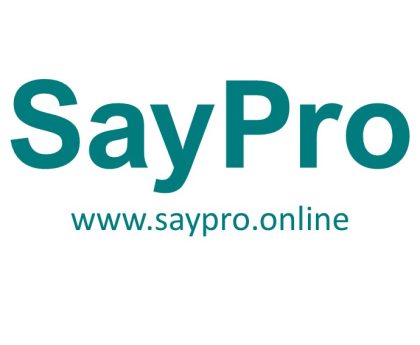SayPro Templates to Use Creative Brief Template: A document for outlining the scope, objectives, target audience, and key messaging for each creative project from SayPro Monthly January SCMR-17 SayPro Monthly Creative Services: Graphic design, video production, and photography by SayPro Online Marketplace Office under SayPro Marketing Royalty SCMR
Purpose of the Template:
The Creative Brief Template is a critical tool for defining the scope, objectives, target audience, and key messaging for each creative project within SayPro’s marketing campaigns. This document serves as a roadmap for all creative work (graphic design, video production, photography), ensuring that the project aligns with business goals, adheres to brand guidelines, and meets stakeholder expectations. By providing clear and structured details, the template allows all team members to stay on the same page, leading to more efficient and effective execution.
1. Project Overview
- Project Title:
A brief title that captures the essence of the project (e.g., “Spring Collection Launch Social Media Graphics” or “Brand Video for New Product Release”). - Project Code/ID:
A unique identifier for the project, often used for tracking purposes (e.g., SCMR-17). - Project Manager:
The person responsible for overseeing the project and ensuring its timely delivery. - Date:
The start date of the creative project. - Deadline:
The final deadline for delivering all assets, including any intermediate deadlines (e.g., drafts, feedback loops).
2. Objectives
- Primary Goal:
Clearly define the overall goal of the creative project. This should focus on what the project aims to achieve (e.g., increase brand awareness, drive product sales, promote an event).- Example: “Create engaging visuals for a social media campaign aimed at increasing traffic to the e-commerce website for the upcoming product launch.”
- Secondary Goals:
Outline any additional goals that support the primary objective, such as enhancing customer engagement, reinforcing the brand message, or generating email signups.- Example: “Encourage customers to follow the brand’s Instagram account by using visually appealing, shareable content.”
3. Target Audience
- Demographics:
Describe the target audience’s key characteristics, including age, gender, location, income level, education, etc.- Example: “Millennials, ages 25-35, living in urban areas, with a strong interest in eco-friendly fashion.”
- Psychographics:
Define the audience’s values, interests, lifestyles, and purchasing behavior that may influence the design of the creative assets.- Example: “Eco-conscious individuals who prioritize sustainable fashion choices and are active on social media platforms like Instagram and Pinterest.”
- Audience Needs:
Identify what the audience wants or needs from this campaign and how the creative work should address these needs.- Example: “The audience needs to feel that the brand shares their values around sustainability and is offering trendy, affordable, and eco-friendly clothing.”
4. Key Messaging
- Main Message:
The core message that should resonate with the audience and be conveyed through all creative materials.- Example: “Sustainably sourced clothing that combines style and eco-consciousness.”
- Supporting Messages:
Any additional messages or calls-to-action (CTAs) that should be incorporated to emphasize important points.- Example: “Join the movement for a greener future with every purchase” or “Shop now for exclusive discounts on our spring collection.”
- Tone and Voice:
Define the tone and voice of the campaign—whether it should be formal, casual, playful, authoritative, etc.- Example: “Friendly, approachable, and socially responsible tone. The messaging should feel conversational but also inspire trust and credibility.”
5. Creative Deliverables
- List of Deliverables:
Provide a detailed list of the creative assets to be produced. This could include:- Graphic Design: Social media banners, email templates, digital ads, posters, etc.
- Video Production: Short video ads, explainer videos, brand films, etc.
- Photography: Product photography, lifestyle images, event photos, etc.
- Example: “Two 15-second social media video ads, three Instagram story templates, one Facebook banner, and five product photos for use in the online store.”
- Format/Resolution Requirements:
Specify the formats and resolution sizes required for each deliverable to ensure the assets are optimized for their intended platforms.- Example: “Instagram Stories – 1080px by 1920px, MP4 format. Facebook Banner – 820px by 312px, JPG format.”
6. Creative Guidelines
- Brand Guidelines:
Reference SayPro’s brand guidelines, ensuring the creative assets adhere to the visual identity, including color schemes, logo usage, typography, and any other design elements that define the brand.- Example: “Use SayPro’s signature green and blue color palette, and ensure the logo is placed in the bottom left corner of all video assets.”
- Design Style:
Define the desired visual style of the creative materials (e.g., minimalist, vibrant, bold, professional, etc.).- Example: “Clean and modern design with a focus on high-quality, minimalist product imagery. Incorporate eco-friendly elements like nature-inspired backgrounds or textures.”
7. Key Stakeholders
- Project Team:
List the individuals or teams responsible for various tasks within the project, including graphic designers, video producers, photographers, content writers, etc.- Example: “Lead Designer: Jane Doe, Video Producer: John Smith, Copywriter: Emily Brown.”
- Approval Process:
Define the approval process and identify who will be responsible for reviewing and approving the creative materials at each stage.- Example: “Initial draft approval – Marketing Manager (Jane Doe), Final approval – Senior VP of Marketing (Tom Harris).”
8. Budget and Resources
- Budget Constraints:
Outline the budget allocated for the project, including any specific limitations (e.g., video production costs, photo shoots, design software licenses).- Example: “Total budget for creative production: $10,000. $4,000 allocated to video production, $3,000 for photography, and $3,000 for graphic design.”
- Required Resources:
List any resources or tools needed to complete the project, such as design software, stock photos, video equipment, or location access for shoots.- Example: “Access to Adobe Creative Suite, stock video footage for B-roll, photo studio for product photography, and budget for hiring models.”
9. Timeline and Milestones
- Project Timeline:
Provide a detailed timeline with key milestones and deadlines for each phase of the creative process (e.g., concept development, first draft, revisions, final delivery).- Example:
- Week 1: Brainstorming and concept creation
- Week 2: First draft of graphics and video storyboard
- Week 3: Photo shoot and video production
- Week 4: Final revisions and feedback
- Week 5: Final approval and asset delivery
- Example:
- Critical Dates:
Include any fixed dates that must be adhered to, such as the campaign launch date, internal review deadlines, or external deadlines for ad placements.
10. Approval and Sign-off
- Sign-Off Section:
A space for stakeholders to approve the creative brief before the project kicks off. This ensures everyone is aligned and gives formal approval to proceed with the outlined plan.- Approved by: [Name]
- Date: [Date]
- Comments/Additional Notes: Space for any final comments or considerations before starting the project.
Conclusion
The Creative Brief Template for SayPro serves as a foundational document to guide all creative projects, providing clear direction and alignment across teams. By detailing project objectives, target audience, key messaging, creative guidelines, and timelines, the brief ensures that every design, video, and photo asset produced aligns with SayPro’s overarching goals, brand identity, and marketing strategy. This template is crucial for ensuring that all creative work is on-target, on-time, and meets stakeholder expectations.



